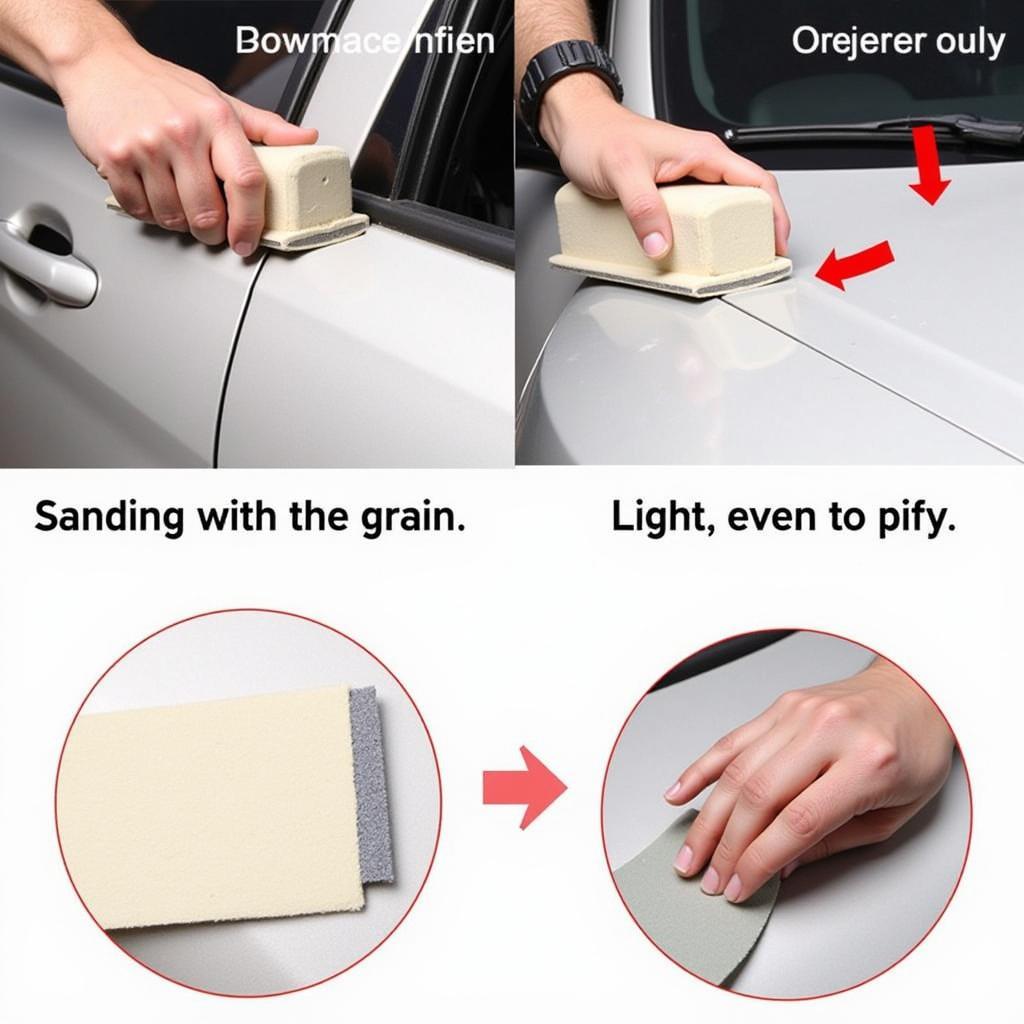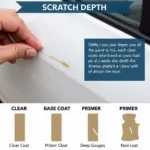Car body repair paper plays a crucial role in achieving a flawless finish during automotive repairs. This guide delves into the various types, applications, and best practices for using car body repair paper, equipping you with the knowledge to make informed decisions for your vehicle’s restoration. We’ll explore everything from sanding techniques to choosing the right grit for different stages of repair. Let’s get started!
What is Car Body Repair Paper?
Car body repair paper, also known as abrasive paper or sandpaper, is a key tool in the body repair process. It is used to smooth surfaces, remove imperfections, and prepare the car body for painting. The paper consists of a backing material coated with abrasive particles, typically aluminum oxide, silicon carbide, or garnet. These abrasive particles come in different grit sizes, ranging from coarse to very fine, each serving a specific purpose in the repair process. Choosing the correct grit is essential for achieving a professional finish. For instance, coarser grits are used for initial shaping and removing significant imperfections, while finer grits are used for final smoothing and preparing the surface for primer.
Shortly after this paragraph, we recommend visiting our resource on DIY car body repair: car body repair do it yourself.
Types of Car Body Repair Paper
There are various types of car body repair paper available, each designed for specific applications. Understanding the differences is critical for selecting the correct paper for your needs.
Dry Sanding Paper
Dry sanding paper is the most common type used in car body repair. It is designed for use without water or lubricants, making it ideal for quick repairs and touch-ups.
Wet Sanding Paper
Wet sanding paper is used with water or a lubricant, which helps to prevent clogging and provides a smoother finish. This is particularly useful when working on curved surfaces or removing fine scratches.
Self-Adhesive Discs
Self-adhesive discs are designed for use with sanding machines, offering greater efficiency and a more uniform finish compared to hand sanding.
Choosing the Right Grit
Selecting the appropriate grit of car body repair paper is paramount for achieving optimal results. Using the wrong grit can lead to uneven surfaces, scratches, or even damage to the car body.
Coarse Grits (40-80)
Coarse grits are used for removing heavy imperfections, such as rust, deep scratches, and old paint.
Medium Grits (100-180)
Medium grits are used for smoothing out the surface after using coarse grits and preparing the area for finer sanding.
Fine Grits (220-400)
Fine grits are used for final smoothing before applying primer and paint. They create a smooth, even surface that is essential for a flawless paint job.
If you are looking for a reputable car body repair shop in Grand Traverse County, MI, you might find our directory helpful: car body repair shop grand traverse county mi.
Techniques for Using Car Body Repair Paper
Proper sanding techniques are crucial for achieving a professional-looking finish. Here are some key tips:
- Use a sanding block: A sanding block provides even pressure and prevents uneven sanding.
- Sand in the direction of the grain: This helps to minimize scratches and create a smoother finish.
- Use light pressure: Applying too much pressure can damage the car body.
- Keep the paper clean: Remove any debris or build-up on the paper to maintain its effectiveness.
 Effective Sanding Techniques for Car Body Repair
Effective Sanding Techniques for Car Body Repair
Car Body Repair in Merthyr Tydfil
Looking for reliable car body repair services in Merthyr Tydfil? Check out our recommendations: car body repair merthyr tydfil.
Common Mistakes to Avoid
Avoid these common mistakes to ensure a high-quality repair:
- Using the wrong grit: This can lead to uneven surfaces and scratches.
- Applying too much pressure: This can damage the car body.
- Sanding in the wrong direction: This can create noticeable scratches.
- Not cleaning the paper: This can reduce the effectiveness of the paper.
“Proper surface preparation is the foundation of a flawless paint job,” says renowned automotive expert, John Davis, a 30-year veteran in the industry. “Using the right car body repair paper and techniques is essential for achieving a smooth and professional finish.” He further emphasizes, “Investing in quality materials and taking the time to master the proper techniques will always pay off in the long run.”
Conclusion
Car body repair paper is a fundamental tool in achieving a professional and long-lasting repair. Understanding the different types, grits, and techniques for using this essential material is crucial for achieving a flawless finish. By following the tips and advice outlined in this guide, you can ensure your car body repairs are done correctly, resulting in a smooth and beautiful finish that will last for years to come.
FAQs
- What is the best grit for removing rust? A coarse grit (40-80) is best for removing rust.
- Should I use wet or dry sanding paper? Wet sanding provides a smoother finish, while dry sanding is better for quick repairs.
- How often should I replace my sanding paper? Replace the paper when it becomes clogged or worn.
- Can I use car body repair paper on plastic bumpers? Yes, but use a finer grit and be cautious to avoid excessive pressure.
- What is the difference between aluminum oxide and silicon carbide sandpaper? Aluminum oxide is more durable, while silicon carbide is sharper and better for finer finishes.
- What is the importance of using a sanding block? A sanding block ensures even pressure and prevents uneven sanding, resulting in a smoother finish.
- Can I reuse car body repair paper? You can reuse it if it’s not clogged or worn, but it’s generally recommended to use fresh paper for optimal results.
For car body repairs in Horley, consider checking out: car body repairs in horley.
You might also find our information on car bodywork repairs near Grave Lane, Marden, Kent helpful: car bodywork repairs near grave lane marden kent.
Need more assistance? Contact us via WhatsApp: +1(641)206-8880 or Email: [email protected]. We have a 24/7 customer support team.

